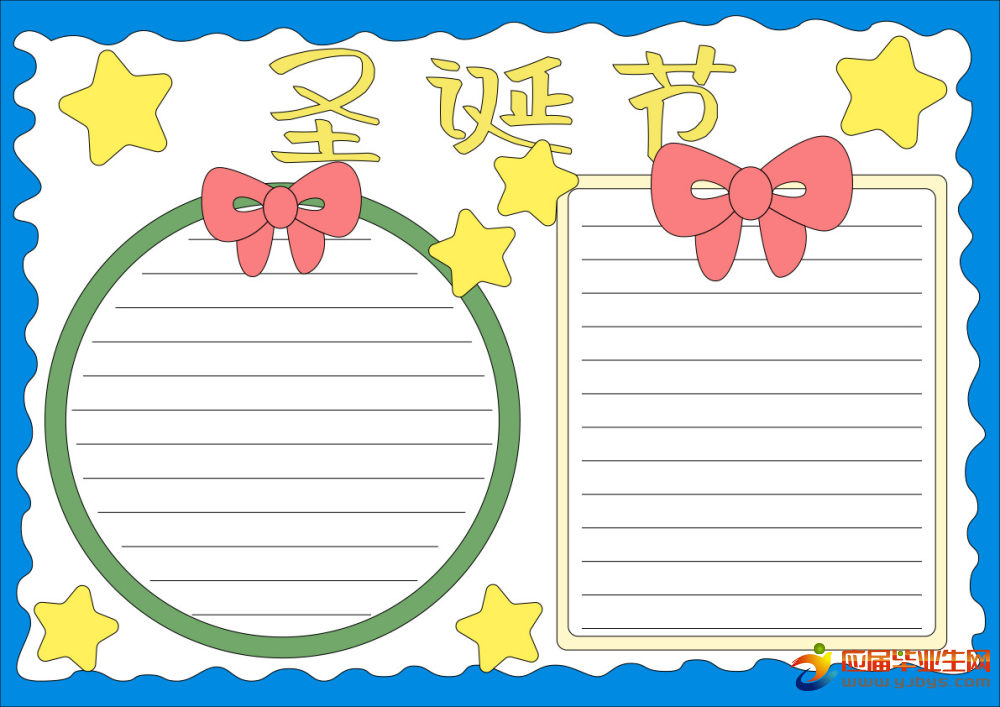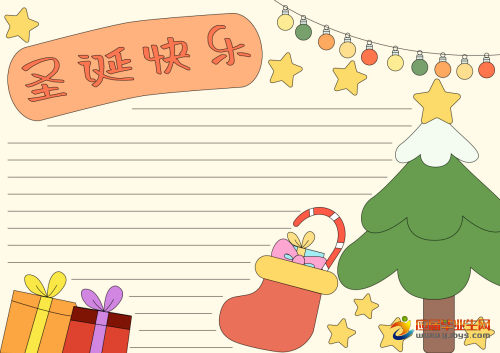- 相關推薦
簡單的圣誕節英語手抄報資料
Christmas cards 圣誕賀卡的起源:
簡單的圣誕節英語手抄報資料





The custom of sending Christmas cards started in Britain in 1840 when the first 'Penny Post' public postal deliveries began. (Helped by the new railway system, the public postal service was the 19th century's communication revolution, just as email is for us today.) As printing methods improved, Christmas cards were produced in large numbers from about 1860. They became even more popular in Britain when a card could be posted in an unsealed envelope for one half-penny - half the price of an ordinary letter.
圣誕賀卡可追溯到1840年統一便士郵政(uniform penny post)的出現,此項改革實現了英國境內郵件遞送費用的標準化。(新鐵路運輸系統為公共郵政服務系統創造了條件,成就了19世紀的通信革命,與電子郵件對現代人的影響無異)。隨著印刷術的改進,從1860年起,每年會生產大量的圣誕賀卡。當郵寄非密封的卡片只要半便士(普通信件郵費的一半)時,郵寄賀卡變得異常流行。
Traditionally, Christmas cards showed religious pictures - Mary, Joseph and baby Jesus, or other parts of the Christmas story. Today, pictures are often jokes, winter pictures, Father Christmas, or romantic scenes of life in past times.
從傳統上來講,圣誕賀卡都印有一些基督教方面的圖片,比如圣母瑪麗,約瑟和小耶穌,或者其它包含有圣誕故事意義的圖片。今天的圣誕賀卡通常是笑話、冬季景致,圣誕老人以及一些反應生活中浪漫場面的圖片。
為什么圣誕節要戴紅色的`圣誕帽,英國人圣誕節戴紙帽子的悠久傳統
All over Britain on Christmas Day, families can be found sitting around their dining tables enjoying a traditional lunch of roast turkey with all the trimmings - and all, regardless of age, wearing coloured paper hats. It is rumoured that even the Queen wears her paper hat over lunch!
圣誕節當天,全英國的家庭都會坐在餐桌前,吃一頓傳統的圣誕大餐,塞滿了各種餡料的烤火雞。無論年齡老幼,所有人都會在頭上戴一頂彩色紙做成的紙帽子。據說,就連伊莉莎白女王也會戴紙帽子哦!
So why this quaint tradition? Where do these paper hats come from? The answer is the Christmas Cracker.
那為什么會有這個古怪的傳統呢?戴紙帽子的傳統來源于哪里?答案就在另一項圣誕傳統活動——圣誕拉炮!
A Christmas Cracker is a cardboard paper tube, wrapped in brightly coloured paper and twisted at both ends. There is a banger inside the cracker, two strips of chemically impregnated paper that react with friction so that when the cracker is pulled apart by two people, the cracker makes a bang.
圣誕拉炮是用硬紙板做的紙筒,再用色彩鮮艷的彩紙包裹在外面,兩端擰緊。在拉炮里會有一個爆竹,當兩個人拉動拉炮兩端時,拉炮里的兩條浸漬紙就會發生摩擦,發出“嘣”的響聲。
Inside the cracker there is a paper crown made from tissue paper, a motto or joke on a slip of paper and a little gift.
拉炮里會裝有紙做的皇冠、寫在紙上的名言或笑話,還會有一些小禮物。
Christmas crackers are a British tradition dating back to Victorian times when in the early 1850s, London confectioner Tom Smith started adding a motto to his sugared almond bon-bons which he sold wrapped in a twisted paper package.
圣誕拉炮成為英國傳統的歷史可以追溯到維多利亞時期,約在19世紀50年代早期,倫敦的一個糖果商湯姆-史密斯把寫有名言的紙片放在了他售賣的糖果包裝里,包裝方式就是在糖果外用紙將兩頭擰緊。
The paper hat was added to the cracker in the early 1900s. The cracker was soon adopted as a traditional festive custom and today virtually every household has at least one box of crackers to pull over Christmas.
到了20世紀初,紙帽子也被放到了圣誕拉炮里。很快,拉炮就成了英國人過圣誕節的傳統習俗。現在,所有的英國家庭至少都會準備一盒拉炮留到圣誕節時來拉響。
【簡單的圣誕節英語手抄報資料】相關文章:
圣誕節英語手抄報資料07-04
英語手抄報圣誕節資料07-01
圣誕節英語手抄報的資料06-18
圣誕節英語手抄報資料大全07-01
圣誕節英語手抄報資料內容07-04
關于圣誕節英語手抄報資料07-04
關于圣誕節的英語手抄報資料07-01
最新圣誕節英語手抄報資料06-21
關于圣誕節英語的手抄報資料06-24